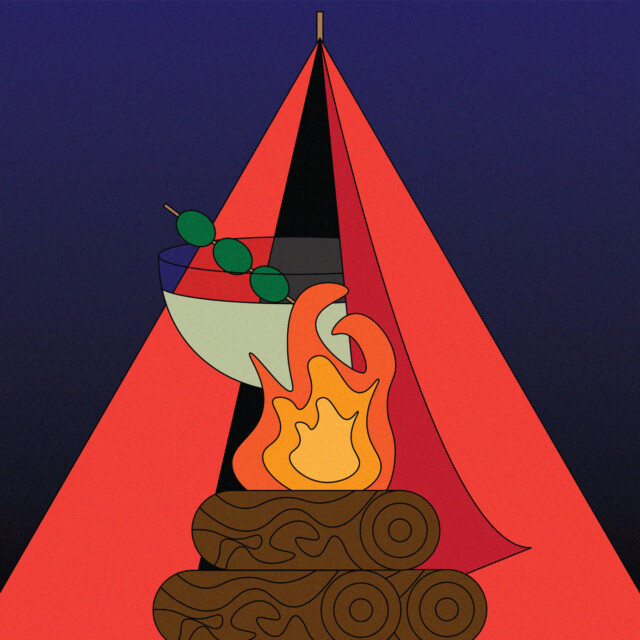A cool fall day, a Gozney pizza oven fired up in the backyard, the wood burning in its chamber, smoke and heat turning raw dough, sauce, and cheese into quick magic. The pizzas came out with just the right char, perfect little bubbles, as if the dough had gotten goosebumps of excitement from cooking this way. I had placed my neat whiskey near the mouth of the oven. Even after a short amount of time exposed to the wood smoke, my drink had changed. Had the smoke lent it new flavors? Or had it deadened my palate?
I’d recently experienced what too much smoke could do to a drink. The other week, I’d cracked open a beer from one of my local brewers; it had been sold at a discount because the hops, the brewer said, had grown in fields near California’s wildfires and the cones had taken on the noxious odors of the burning forests, which left death and destruction and ruined crops across the state.
As much as smoke, fire, and char can play villain, they can also be quite essential to alcohol or its ingredients. Peat fires dry out malted barley for that smoky flavor in Scotch. Bourbon is aged in charred oak because charring the barrel allows the liquid to extract more flavors from the wood, like notes of vanilla and caramel. The list is long.
Bringing New Flavors With Smoke and Char
Smoking certain ingredients — or even a whole drink — can transform a cocktail’s flavors, too. It also makes wood-fire cooking a lot more enjoyable.
“Smoking fruit adds this whole other depth to the cocktail,” says Shane McBride, partner at Pig Beach, a barbecue joint with locations in New York and Florida. For his cocktails, McBride has smoked everything from peaches to lemons; mangos to pineapples. “Tropical fruits take smoke really well,” he says. “The acid from the fruit and the smoke pops.” He especially recommends smoking fruit with its own wood: peaches with peachwood, apple with apple, even grapes with their dried-out vines. Fruit wood, he says, “is a more subtle smoke. If you’re smoking pineapple with hickory, you’re going to lose all the flavors of the fruit.”
Michael Laudenslager, sommelier and manager of the beverage program at Peasant in Manhattan, slides a cast iron pan next to the applewood fire to char Amarena cherries. Instead of making a Martinez, he spins the gin drink so that when it’s mixed with sweet vermouth, cherry liquor, and a cherrywood tincture (made from steeping cherrywood in water for 36 hours), the slightly burnt fruit gives the drink — now named Martina — completely new life.
Back at Pig Beach, McBride smokes apples on applewood, creating a purée from the smoked fruit. Combining the purée with apple cider and Applejack whiskey yields something akin to an Old Fashioned that has “an apple explosion with a nice whisper of smoke,” he says.
While wood-fire cooking has long been accompanied by beer and whiskey, Laudenslager recommends pairing homemade barbecue with red wine. “Chilling mutes certain flavors,” he says, which is why he likes to refrigerate more expressive wines, tamping down those bitter tannins. “But we can actually bring a flavor back into the wine by pairing it with a good char or some type of barbecue.” For instance, a tomato gets very sweet when charred. By pairing the ingredient with a bold, chilled wine, flavors from the transformed tomato bring life back to the muted beverage.
Avoiding Smoked-Out Palates
Just as chilling a wine can subdue its flavors, cooking on smoke all day can inadvertently mute your own taste buds. Ribdiculous, McBride’s barbecue team, meets yearly for a barbecue competition, huffing in smoke all day. Because the competition is part party, they want to also enjoy drinks during the process, but ones that will also combat their palate fatigue. To keep their taste buds in peak form, McBride and his squad sip Negronis with a rim of barbecue rub. The salt, various sugars and honeys, dried thyme, and paprika on the glass act as a hard reset for the brain, allowing one to begin reprocessing flavors again. The bitterness of Campari helps, too, says McBride. Some chefs turn to rosés, but Laudenslager says that highly aromatic white wines — like Arneis, Vermentino, and Pigato — are his preference for settling the palate.
Not into smoking foods but still want to explore the flavor in your beverage? Outside of smoke guns, you can light up your preferred wood (or herbs or whole spices), capture smoke in a glass, then quickly pour in your pre-shaken or pre-stirred cocktail before the smoke drifts away. Or, to ease yourself into its often intense, layered aromas, you can add smoke to water, freeze it into cubes, and enjoy a slow release of smoke into your beverage as the ice melts.
